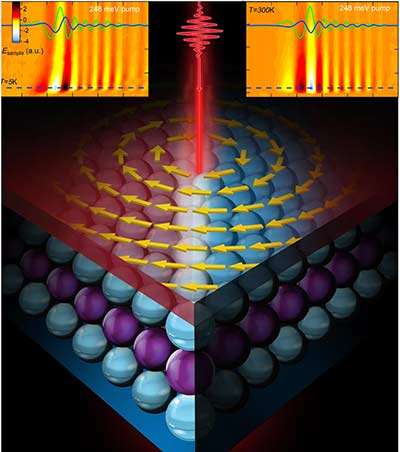Feb. 14, 2019
Scientists at the U.S. Department of Energy’s Ames Laboratory have discovered a means of controlling the surface conductivity of a three-dimensional (3D) topological insulator, a type of material that has potential applications in spintronic devices and quantum computing.
3D topological insulators are emerging materials that hold great promise due to their unique electron conducting states on their surfaces, immune to backscattering, versus the bulk interior, which behaves as a normal insulator.
But a challenge remains in underpinning and selectively controlling their high frequency transport at the surface without an increased scattering from the bulk material.
By employing ultra-short mid-infrared and terahertz pulses of less than one trillionth of a second, researchers at Ames Laboratory were able to successfully isolate and control the surface properties of a bismuth-selenium (Bi2Se3) 3D topological insulator.
The method provides what is essentially a new “tuning knob” for controlling the protected surface conductivity in this category of materials.
“We believe that this study could evolve into a benchmark method of characterizing and manipulating these materials, so they can be better understood and adapted for applications in new quantum technologies,” said Jigang Wang, Ames Laboratory physicist and Iowa State University professor.
The research is further discussed in a paper, “Ultrafast manipulation of topologically enhanced surface transport driven by mid-infrared and terahertz pulses in Bi2Se3,” authored by L. Luo, X. Yang, X. Liu, Z. Liu, C. Vaswani, D. Cheng, M. Mootz, X. Zhao, Y. Yao, C.-Z. Wang, K.-M. Ho, I.E. Perakis, M. Dobrowolska, J.K. Furdyna and J. Wang; and published as an Editor’s Highlight in Nature Communications.
Ames Laboratory is a U.S. Department of Energy Office of Science national laboratory operated by Iowa State University. Ames Laboratory creates innovative materials, technologies and energy solutions. We use our expertise, unique capabilities and interdisciplinary collaborations to solve global problems.
DOE’s Office of Science is the single largest supporter of basic research in the physical sciences in the United States, and is working to address some of the most pressing challenges of our time. For more information, please visit science.energy.gov.













